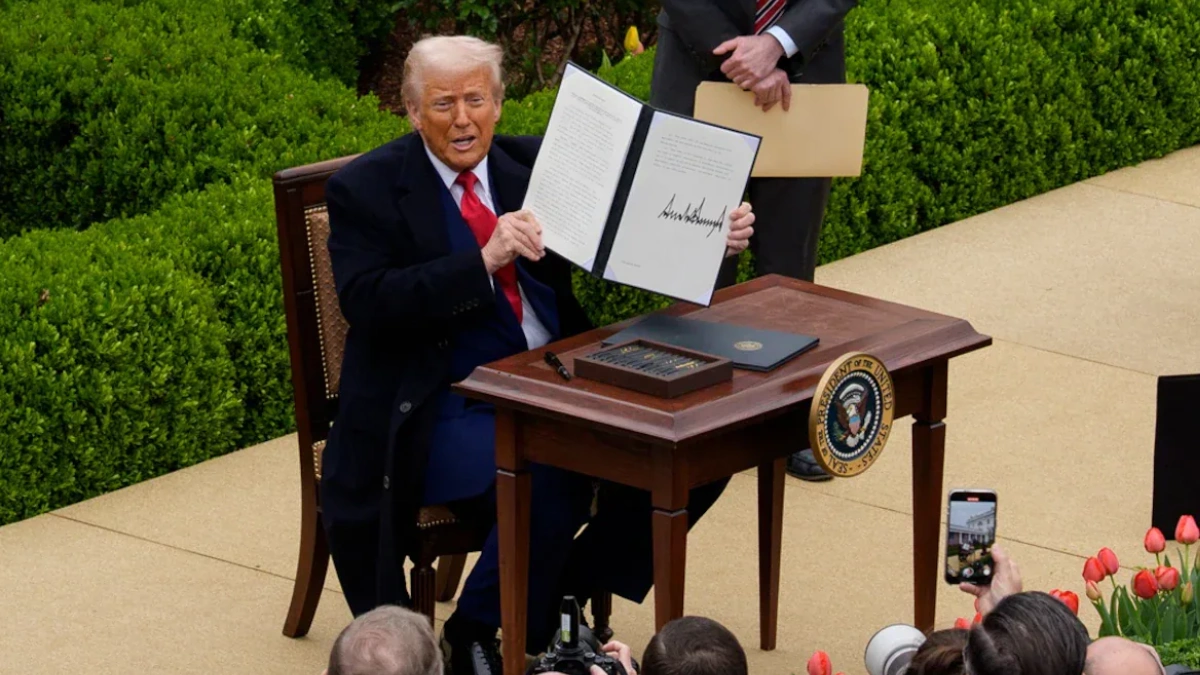
The Global Trade landscape was completely different when U.S. President Donald Trump launched his tariff campaign less than six months ago. India seemed to be in a good position for a speedy trade agreement, but China seemed to be the main aim. Despite substantial goods trade deficits with America, traditional U.S. allies like Japan, South Korea, the UK, and Australia seemed immune to harsh measures. Strong punitive penalties were anticipated for Russia, which is now involved in its war on Ukraine. Since Switzerland had maintained its neutrality for so long, it appeared that its tariff rates would only be somewhat higher than those of the EU.
That first anticipation has been defied today. Trump’s trade agenda’s once-predictable winners and losers have switched positions, exposing a convoluted and politically motivated tariff environment.
Trump Administration Threatens Harvard’s Control Over Patents Amid Escalating Tensions
Unexpected Winners and Losers

Ironically, two of the three democracies in the BRICS are now subject to the highest U.S. tariffs in the world: Brazil and India. Not far behind is the other BRICS democracy, South Africa. Russia is being courted with the possibility of a presidential summit, but has avoided any significant economic consequences despite its ongoing bombardment of Ukrainian villages.
After a possible bilateral agreement, China, which initially responded against U.S. tariffs, is now in a better position and could get even better conditions. Even though Israel is an aggressor in another unresolved conflict, it has only been subject to a 15% tariff, which is the lowest rate for nations with a trade surplus with the United States.
While the UK and Australia face 10% tariffs, three times higher than pre-Trump averages, despite having less exports to the U.S. than imports, Switzerland is now subject to duties that are more than twice as high as those imposed on the EU.
Indian Stock Markets on Edge as Tariff Concerns Intensify Trade Uncertainty
Tariffs as a Tool for Diplomacy and Pressure

Trump has used tariffs to further his diplomatic and geopolitical goals in addition to using them as an economic pressure tool.
- Canada: 35% tariffs, in part because of the backing for Palestinian statehood.
- Brazil: 50% tariffs for allegedly mistreating former President Jair Bolsonaro.
- Mexico: High tariffs for not regulating the import of fentanyl and the movement of people.
- Colombia: Threatened with heavy tariffs if deportees are not accepted.
- Spain: Targeted because of their unwillingness to raise defence expenditures.
Because of this aggressive approach, tariff policy is unstable and can change course in as little as ten days, leaving trading partners uneasy and responsive.
India–US Trade Talks: Concessions, US Cotton, and Concerns Ahead of Key Negotiations
China’s Gradual Accommodation

Beijing seems to be using trade power and retaliatory actions to get concessions as it works its way down Trump’s tariff scale. It appears that U.S. policymakers are now more willing to make accommodations for China. Possible developments include:
- An extension of the current tariff pause.
- A summit between Trump and Chinese President Xi Jinping.
- Deals on contentious issues such as TikTok.
- Chinese pledges to buy more U.S. agricultural or energy products.
Decades of American diplomatic efforts to distance India from Russia and oppose Chinese hegemony in the Indo-Pacific may be jeopardised by this warming of ties between the United States and China.
OpenAI Launches GPT-5: India Positioned as Key Market in Global AI Push
Strain on India-U.S. Relations

Developing relations with India has been a strategic endeavour for Washington throughout the course of three decades and several U.S. administrations. The two democracies have common interests in defence cooperation, technology, and the impact of the Indian diaspora in the United States.
New Delhi first believed that the United States will maintain a favourable tariff gap between India and China, ranging from 10% to 20%. Additionally, it was anticipated that Washington will uphold India’s long-standing stances, including defending its labour-intensive manufacturing base and shielding its agriculture sector from genetically modified insects. These presumptions have now been disproved, endangering the bilateral goodwill that has been cultivated over time.
Political Fallout of Trump’s Strategy

Trump’s politically charged public remarks, which are frequently directed at his home audience, are difficult for many democratic leaders to reconcile with their own internal narratives. Authoritarian regimes in China, Russia, and some regions of West Asia can easily avoid these political conflicts, while democracies have a harder time upholding agreements that are seen as unfair.
Even if the economic terms are fair, it is politically costly for these leaders to comply because of Trump’s tendency of accusing him of “bullying” them into making historic concessions.
India Notifies WTO of Tariff Response to U.S. Auto Duties Affecting $2.8 Billion in Exports
Strengthening the Russia–China–India Axis

Ironically, it’s possible that Trump’s tariffs are bringing together some of the biggest economies in the world, including China, Brazil, Russia, and India. Deeper collaboration between these countries is being fostered by shared grievances against the United States, which might work to Washington’s detriment for both Beijing and Moscow.
The harsh tariff measures intended to improve America’s standing in the world may actually hasten the development of counterbalances to American power if this trend persists.
Conclusion
Trump’s tariff war has transformed from a focused economic tactic into a volatile geopolitical instrument that is unexpectedly altering alliances and conflicts. Once-aligned nations now face higher tariffs than their adversaries, and the drive for domestic political gains is posing long-term strategic problems overseas.
